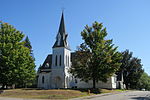Souza-Baranowski Correctional Center
Souza-Baranowski Correctional Center (SBCC) is a maximum security prison in Lancaster, Massachusetts (though it receives mail through a post-office box in the town of Shirley). It is operated by the Massachusetts Department of Correction. It is close to the medium-security prison Massachusetts Correctional Institution – Shirley, which is directly to the north over the town border. Souza-Baranowski opened on September 30, 1998. As of January 6, 2020 SBCC housed 672 inmates in general population beds.The prison is named in honor of a corrections officer, James Souza, 29, and an instructor Alfred Baranowski, 54, who were shot in July 1972 by an inmate whose wife had smuggled in handguns into what was then the Norfolk Prison Colony. Souza-Baranowski is the only post-conviction maximum-security state prison in Massachusetts. Massachusetts Correctional Institution – Cedar Junction operates a pre-trial maximum-security "reception and diagnostic center", and the Federal Medical Center, Devens operates at all security levels, including maximum.
Excerpt from the Wikipedia article Souza-Baranowski Correctional Center (License: CC BY-SA 3.0, Authors).Souza-Baranowski Correctional Center
Harvard Road,
Geographical coordinates (GPS) Address External links Nearby Places Show on map
Geographical coordinates (GPS)
| Latitude | Longitude |
|---|---|
| N 42.523333333333 ° | E -71.648055555556 ° |
Address
Souza-Baranowski Correctional Center
Harvard Road
01464
Massachusetts, United States
Open on Google Maps








